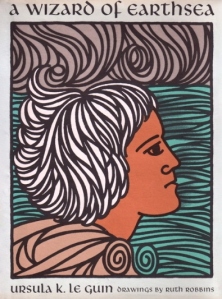 Some 17 years after Le Guin completed the original Earthsea trilogy, she returns to the isle of Gont. This time she focuses on Tenar from The Tombs of Atuan, but also Sparrowhawk remains an important character, and Arren from The Farthest Shore plays a part as well.
Some 17 years after Le Guin completed the original Earthsea trilogy, she returns to the isle of Gont. This time she focuses on Tenar from The Tombs of Atuan, but also Sparrowhawk remains an important character, and Arren from The Farthest Shore plays a part as well.
It’s commonly known Le Guin wrote this book partly to rectify the gender imbalance in the initial trilogy, and in the fantasy genre in general. Indeed: wizards and mages are Men, and females with magical powers generally are foul witches or servile priestesses. The medieval setting of most fantasy stories is filled with patriarchy and Kings – nobody needs to be convinced of that. So yes, in today’s parlance, Tehanu is woke – but not fully woke, as I’ll try to explain.
Before I write a bit on the book’s political issues, let me try to give an overall appraisal of Tehanu, without spoiling the first three books.






